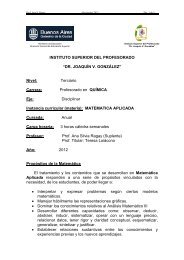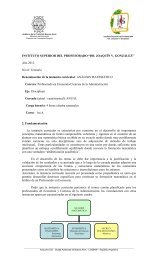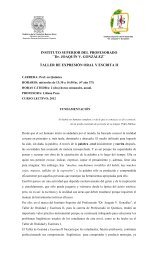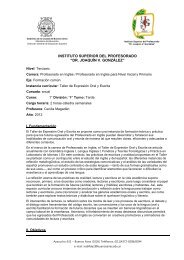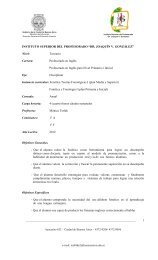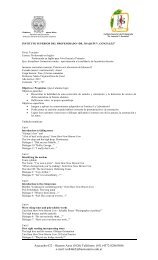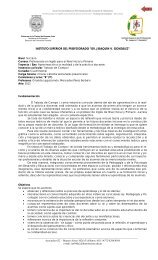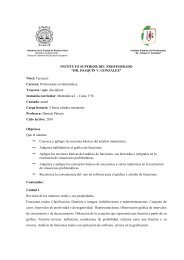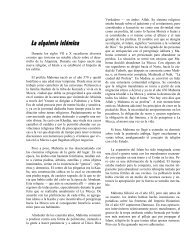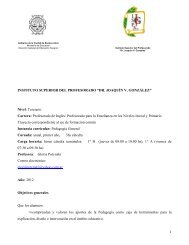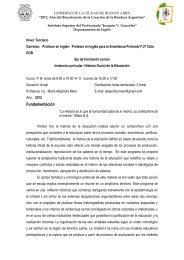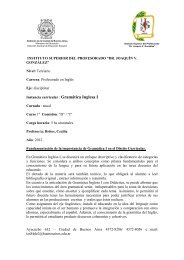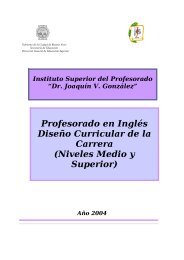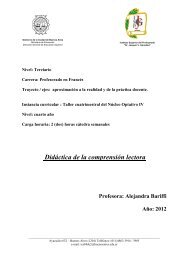Los retos de la historia oral en el siglo XXI: diversidades ...
Los retos de la historia oral en el siglo XXI: diversidades ...
Los retos de la historia oral en el siglo XXI: diversidades ...
You also want an ePaper? Increase the reach of your titles
YUMPU automatically turns print PDFs into web optimized ePapers that Google loves.
Sesiones parale<strong>la</strong>s / Parall<strong>el</strong> sessionsestas l<strong>en</strong>guajes como expresiones <strong>de</strong> discursos histórico, artístico y culturalmarcados por <strong>el</strong>em<strong>en</strong>tos éticos, <strong>de</strong> ficción, pa<strong>la</strong>bras e imág<strong>en</strong>es, memorias<strong>en</strong> construcción, recursos, informes <strong>de</strong>l pasado y pres<strong>en</strong>te. El c<strong>en</strong>tro <strong>de</strong> <strong>la</strong>discusión es <strong>la</strong> p<strong>el</strong>ícu<strong>la</strong> docum<strong>en</strong>tal y <strong>la</strong> etnografía escrita. Destacamos <strong>en</strong> <strong>la</strong>investigación y creación <strong>de</strong> <strong>la</strong> narrativa <strong>en</strong> <strong>el</strong> cine y <strong>la</strong> etnografía escrita, narraciónimersa <strong>en</strong> un juego dinámico y complejo que implica <strong>la</strong> técnica, realidad,ficción y poesía. La int<strong>en</strong>ción es llevar a cabo una escritura etnográfica,basado <strong>en</strong> <strong>la</strong> composición <strong>de</strong> imág<strong>en</strong>es, sones y pa<strong>la</strong>bras. Una etnografía qu<strong>en</strong>os permite <strong>de</strong>scribir y evaluar <strong>la</strong>s experi<strong>en</strong>cias <strong>en</strong> <strong>el</strong> trabajo <strong>de</strong> campo y <strong>en</strong> <strong>la</strong>realización <strong>de</strong> docum<strong>en</strong>tales, pres<strong>en</strong>tar, <strong>de</strong> forma más e<strong>la</strong>borada, <strong>en</strong> termos<strong>de</strong> estudios conceptuales y metodológicos y <strong>de</strong> investigación etnográfica queresultarán <strong>en</strong> docum<strong>en</strong>tales etnográficos “Pasos <strong>de</strong> Oeiras” [2008], “Congo: Elritmo y <strong>la</strong> <strong>de</strong>voción” [2009] y “Las Esc<strong>la</strong>vas <strong>de</strong> <strong>la</strong> Madre <strong>de</strong> Dios” [2010].We pres<strong>en</strong>t the results of investigations with audiovisual <strong>la</strong>nguages in or<strong>de</strong>r to<strong>de</strong>cipher compositions of words, images and sounds. We b<strong>el</strong>ieve these <strong>la</strong>nguagesare the expressions of historical, artistic and cultural dialogues, markedby <strong>el</strong>em<strong>en</strong>ts that are ethical, fictional and real; words and images, memoriesun<strong>de</strong>r construction, reports and records of the past and pres<strong>en</strong>t. The c<strong>en</strong>terof our reflections is the docum<strong>en</strong>tary film and ethnographic writing. We haveemphasized the investigation and the creation of filmic and ethnographic narratives,both immersed in a dynamic and complex game that involves editingtechniques and poetic liberty. The int<strong>en</strong>tion is to <strong>de</strong>v<strong>el</strong>op other narratives that<strong>en</strong>able us to interpret and evaluate fi<strong>el</strong>d work experi<strong>en</strong>ces and the making ofdocum<strong>en</strong>taries; to e<strong>la</strong>borat<strong>el</strong>y pres<strong>en</strong>t concepts and methodologies of ethnographicand <strong>oral</strong> investigation, which resulted in the ethnographic docum<strong>en</strong>taries“Steps of Oeiras” [2008] “Congo: rhythm and <strong>de</strong>votion” [2009] and “theS<strong>la</strong>ves of God’s Mother” [2010].Tornay, Liz<strong>el</strong> y Alvarez, VictoriaEntre pa<strong>la</strong>bras e imág<strong>en</strong>es: viol<strong>en</strong>cia <strong>de</strong> género <strong>en</strong>C<strong>en</strong>tros C<strong>la</strong>n<strong>de</strong>stinos <strong>de</strong> Det<strong>en</strong>ción y cárc<strong>el</strong>es <strong>en</strong> <strong>el</strong>terrorismo <strong>de</strong> Estado (1973-1983). Cine e HistoriaOral. Maneras <strong>de</strong> conocer <strong>el</strong> pasadoTanto <strong>en</strong> los C<strong>en</strong>tros C<strong>la</strong>n<strong>de</strong>stinos <strong>de</strong> Det<strong>en</strong>ción y Tortura exist<strong>en</strong>tes <strong>en</strong> <strong>la</strong> Arg<strong>en</strong>tinadurante <strong>la</strong> última dictadura militar como <strong>en</strong> <strong>la</strong>s cárc<strong>el</strong>es se <strong>de</strong>sarrol<strong>la</strong>ronprácticas sistemáticas <strong>de</strong> viol<strong>en</strong>cia sexual. Solo <strong>en</strong> algunos <strong>de</strong> los últimosjuicios -2011- estas prácticas fueron consi<strong>de</strong>radas y juzgadas como <strong>de</strong>lito <strong>de</strong>lesa humanidad con carácter autónomo difer<strong>en</strong>ciado <strong>de</strong> los <strong>de</strong>litos <strong>de</strong> tortura.Sin embargo muchas mujeres que sufrieron esas situaciones lo <strong>de</strong>nunciaron<strong>de</strong>s<strong>de</strong> que salieron <strong>en</strong> libertad.La int<strong>en</strong>ción <strong>de</strong> este trabajo es indagar los itinerarios <strong>de</strong> construcción <strong>de</strong> <strong>la</strong>/smemoria/s colectiva/s a través <strong>de</strong> los testimonios <strong>de</strong> <strong>la</strong>s víctimas <strong>en</strong> diálogo/t<strong>en</strong>sión con los discursos jurídicos, con los movimi<strong>en</strong>tos <strong>de</strong> Derechos Humanosy con los movimi<strong>en</strong>tos <strong>de</strong> mujeres. Qui<strong>en</strong>es sufrieron esa viol<strong>en</strong>cia lo<strong>de</strong>nunciaron, le pusieron pa<strong>la</strong>bras, le dieron visibilidad <strong>de</strong>snaturalizando <strong>la</strong>sre<strong>la</strong>ciones jerárquicas <strong>de</strong> género <strong>en</strong> <strong>la</strong>s que se basan estas prácticas.El análisis se c<strong>en</strong>trará <strong>en</strong> <strong>en</strong>trevistas realizadas a ex <strong>de</strong>t<strong>en</strong>idas-<strong>de</strong>saparecidasy/o presas durante Terrorismo <strong>de</strong> Estado vig<strong>en</strong>te <strong>en</strong> Arg<strong>en</strong>tina <strong>en</strong>tre 1975 y1983. Pa<strong>la</strong>bras e imág<strong>en</strong>es <strong>de</strong> <strong>la</strong>s <strong>en</strong>trevistas y <strong>de</strong> fotografías aportadas por<strong>el</strong><strong>la</strong>s se complem<strong>en</strong>tan <strong>en</strong>riqueci<strong>en</strong>do y complejizando <strong>el</strong> re<strong>la</strong>to.So much in the Secret C<strong>en</strong>ters of Det<strong>en</strong>tion and Torture that have be<strong>en</strong> exist<strong>en</strong>cein Arg<strong>en</strong>tina during the <strong>la</strong>st military dictatorship as in the jails they were <strong>de</strong>v<strong>el</strong>opedpractical systematic of sexual viol<strong>en</strong>ce. Alone in some of the <strong>la</strong>st trials -2011- these practices were consi<strong>de</strong>red and judged as hurt humanity’s crime with autonomousdiffer<strong>en</strong>tiated character of the torture crimes. However many wom<strong>en</strong>that suffered those situations <strong>de</strong>nounced it since they left in freedom.The int<strong>en</strong>tion of this work is to investigate the itineraries for the constructionof the memory/s collective/s through the testimony of the victims in dialog/t<strong>en</strong>sion with the legal discourses, with the Human Rights movem<strong>en</strong>ts and withthe wom<strong>en</strong>’s movem<strong>en</strong>t. Those who have suffered such viol<strong>en</strong>ce reported thosesituations, they’ve put them into words, giving visibility to this viol<strong>en</strong>ce and<strong>de</strong>naturalizing the hierarchical re<strong>la</strong>tionships of g<strong>en</strong><strong>de</strong>r in which these practicesare based.The analysis will focus on interviews with former <strong>de</strong>tained and disappearedand/or dams during Sate Terrorism in Arg<strong>en</strong>tina betwe<strong>en</strong> 1975 an 1983. Wordsand images of the interviews an photographs provi<strong>de</strong>d by them is <strong>en</strong>richingand getting the stories more complexes.Scar<strong>el</strong>i, GiovannaCine e Historia Oral. Maneras <strong>de</strong> conocer <strong>el</strong> pasadoThe objective of this article is to analyze the movie Santo Forte (1999) byEduardo Coutinho, trying to un<strong>de</strong>rstand how the “Oral Story” methodologyand cinematographic techniques may reveal contexts and conjunctures of atime and p<strong>la</strong>ce evoking reflections on the re<strong>la</strong>tion betwe<strong>en</strong> reality and fiction.Santo Forte is a movie in which the director makes contact with the charactersby using the Oral Story methodology. To analyze it, this article is substantiatedon qualitative researches, working on the perspective of the analysis ofthe images proposed by the docum<strong>en</strong>tary method (Bauer, Gask<strong>el</strong>l, 2010) andbibliographic research. The int<strong>en</strong>t of this work was to better un<strong>de</strong>rstand whatis told and what aspects of life are privileged, since the director asks questionsregarding r<strong>el</strong>igion in the beginning of the interview. That is all because manylife aspects “escape” r<strong>el</strong>igion and we become aware of some fragm<strong>en</strong>ts ofthese characters‘ lives. According to Comolli (1997, p.182) cinema puts us in aposition in which we are able to see the other one, like a story book that op<strong>en</strong>sits<strong>el</strong>f in sounds and images. If cinema can be consi<strong>de</strong>red a “story book”, we canalso consi<strong>de</strong>r its characters as active ag<strong>en</strong>ts of the story and by exposing theirmemories in the form of words, we manage to build this story. Fragm<strong>en</strong>ts of apast, always pres<strong>en</strong>t, in the pres<strong>en</strong>t, and always new because nothing is as itwas before, since everything changes according to each interpretation and byeach visit to the past. This way we assume that this movie may be consi<strong>de</strong>red awork that brings the spectator pieces of a past of these people who live in Vi<strong>la</strong>Parque da Cida<strong>de</strong>, in Rio <strong>de</strong> Janeiro, Brazil. In this case the cinema throughthe Oral Story methodology provi<strong>de</strong>d the access to these stories which wewouldn’t have had by other means.En este artículo se pret<strong>en</strong><strong>de</strong> analizar <strong>la</strong> p<strong>el</strong>ícu<strong>la</strong> Santo Forte (1999) <strong>de</strong> EduardoCoutinho, buscando <strong>en</strong>t<strong>en</strong><strong>de</strong>r como <strong>la</strong> motodología <strong>de</strong> <strong>la</strong> Historia Oral combinadacom <strong>la</strong>s tecnicas cinematográficas pue<strong>de</strong> reve<strong>la</strong>r, <strong>de</strong> forma creíble, contextosy situaciones especificas <strong>de</strong> un tiempo y <strong>de</strong> un lugar, o que por su vez<strong>de</strong>sarrol<strong>la</strong> reflexiones sobre <strong>la</strong> re<strong>la</strong>ción <strong>en</strong>tre realidad y ficción. Santo Forte esuna p<strong>el</strong>ícu<strong>la</strong>, em <strong>la</strong> que <strong>el</strong> director se puso <strong>en</strong> conctato con los personajes utilizando<strong>la</strong> metodologia <strong>de</strong> <strong>la</strong> História Oral. Para analizarlo, iciemos <strong>la</strong> base <strong>de</strong>nuestro <strong>en</strong>sayo, <strong>en</strong> <strong>la</strong>s investigaciones cualitativas, trabajando <strong>de</strong>s<strong>de</strong> <strong>la</strong> perspectiva<strong>de</strong> <strong>la</strong> metodología <strong>de</strong> análisis <strong>de</strong> imag<strong>en</strong> propuestas por <strong>el</strong> método docum<strong>en</strong>tal(Bauer, Gask<strong>el</strong>l, 2010) y <strong>en</strong> <strong>la</strong> investigación <strong>en</strong> <strong>la</strong> literatura. Ent<strong>en</strong><strong>de</strong>rlo que cu<strong>en</strong>tam y que aspectos <strong>de</strong> <strong>la</strong> vida privilegiam, ya que <strong>el</strong> director haceuma pergunta guía sobre <strong>la</strong> r<strong>el</strong>igión <strong>en</strong> <strong>el</strong> princípio <strong>de</strong> <strong>la</strong> <strong>en</strong>trevista, fue nuestroobjectivo. Esto se <strong>de</strong>be a muchos aspectos <strong>de</strong> <strong>la</strong> vida escapar <strong>de</strong> <strong>la</strong> r<strong>el</strong>igión yconocemos los fragm<strong>en</strong>tos <strong>de</strong> <strong>la</strong> vida <strong>de</strong>stos personajes. De acuerdo con Comolli(1997, p. 182) <strong>el</strong> cine nos pone <strong>en</strong> uma posición com <strong>el</strong> po<strong>de</strong>r <strong>de</strong> ver otroscomo “um libro <strong>de</strong> <strong>historia</strong>s”, que se abre <strong>en</strong> imág<strong>en</strong>es y sonidos. Si <strong>el</strong> cine pue<strong>de</strong>ser consi<strong>de</strong>rado uno “libro <strong>de</strong> <strong>historia</strong>”, también consi<strong>de</strong>ramos que sus personajesson sujeitos ag<strong>en</strong>tes <strong>de</strong> esta <strong>historia</strong> y, por médio <strong>de</strong> <strong>la</strong> exposición <strong>de</strong>sus recuerdos <strong>en</strong> forma <strong>de</strong> pa<strong>la</strong>bras, estas <strong>historia</strong>s pue<strong>de</strong>m ser, fragm<strong>en</strong>tos<strong>de</strong> un pasado, siempre pres<strong>en</strong>te, siempre em <strong>el</strong> pres<strong>en</strong>te y siempre nuevo, porqu<strong>en</strong>ada es como antes, ya que todo cambia cada interpretación, cada nuevavisita al passado. Supuesto observando cuando se utiliza <strong>la</strong> metodologia <strong>de</strong><strong>la</strong> história <strong>oral</strong>. Por lo tanto, creemos que esta p<strong>el</strong>ícu<strong>la</strong> se pue<strong>de</strong> consi<strong>de</strong>raruna obra que lleva a los espectadores, fragm<strong>en</strong>tos <strong>de</strong> un pasado <strong>de</strong> personas,resi<strong>de</strong>ntes <strong>de</strong> <strong>la</strong> Vi<strong>la</strong> Parque <strong>de</strong> <strong>la</strong> Ciudad, ubicada em Rio <strong>de</strong> Janeiro, <strong>en</strong> Brasil.El cine, <strong>en</strong> este caso, utilizando <strong>la</strong> metodologia <strong>de</strong> <strong>la</strong> <strong>historia</strong> <strong>oral</strong>, fue lo quefacilitó <strong>el</strong> acceso <strong>la</strong>s <strong>historia</strong>s, que, quizá, no t<strong>en</strong>driamos <strong>de</strong> otro modo.Rayner, Mich<strong>el</strong>leAural/<strong>oral</strong> history media productions‘The past is a movie re<strong>el</strong>, p<strong>la</strong>ying insi<strong>de</strong> my head – but ev<strong>en</strong> better than a film,because I’m able to step insi<strong>de</strong> the space that is my imagination’...this is how alist<strong>en</strong>er <strong>de</strong>scribed the experi<strong>en</strong>ce of hearing audio history docum<strong>en</strong>taries, eitheron the radio.Sound and word – words and sound – these are two of the most powerful toolsfor communication In aural/<strong>oral</strong> history media productions, which involve r<strong>en</strong><strong>de</strong>ringthe past, personal and collective experi<strong>en</strong>ces and ev<strong>en</strong>ts in history, weuse the craft and <strong>la</strong>nguage of sound – both verbal and non-verbal - to re-createhistorical time and experi<strong>en</strong>ce. The audio docum<strong>en</strong>tary can offer a powerfu<strong>la</strong>nd visceral insight, almost an immersion, in the past, into individual experi<strong>en</strong>ceand emotion, in any time or p<strong>la</strong>ce – whether it is Shakespeare’s Eng<strong>la</strong>nd,the battlefi<strong>el</strong>ds of the American civil war, or the noisy, protest fu<strong>el</strong>led streets ofParis, Tokyo, or Bu<strong>en</strong>os Aires 1968.In this paper, using a mix of examples from audio history docum<strong>en</strong>taries, andanalysis of the aural/<strong>oral</strong> history nexus, i will illuminate the power and pot<strong>en</strong>tialof ‘t<strong>el</strong>ling stories in sound’I will also briefly illustrate the way in which the online media world is expandingthe way in which docum<strong>en</strong>tary producers are t<strong>el</strong>ling history – through amix of audio/<strong>oral</strong> history/images and text.I will use the example of a rec<strong>en</strong>t online history project for ABC Radio Australia,39



